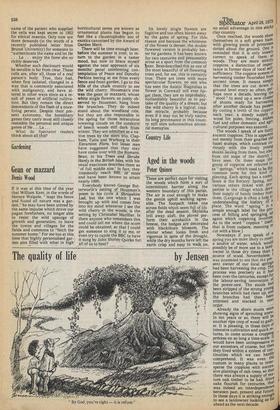Country Life
Aged in the woods
Peter Quince
_ _
These are perfect days for visiting the woods which form a sort of intermittent barrier along the western boundary of this parish. The air is cool enough to make the gentle uphill walking agreeable. The footpath takes one across fields which seem full of life after the dead season. Skylarks trill away aloft, the plover perform their acrobatics in the breeze, the hedges are decorated with blackthorn blossom. The winter wheat looks fresh and vigorous in spite of the drought, while the dry months have left the earth crisp and easy to walk on,
no small advantage in this stickY clay country.
Once reached, the woods shoW themselves in a soft green haze, With glowing pools of primroses dotted about the ground. One is reminded that it is only loosely correct to speak of them as woods. They are more strictlY coppices, a distinction of impor" tance in former days of local selfsufficiency. The coppice system of harvesting timber flourished froln ancient times. It means siMplY that the trees are cut down t° ground level every so often, Pel" haps once a decade, leaving the " stool" to send up a new cluster of shoots ready for harvesting after another decade has pass' By cutting a tenth of thecopPIC`r each year, a steady supplY d' wood for poles, fencing, stakes' fuel and other domestic and agricultural purposes was assured., The woods I speak of are fairly ancient coppices. This is apparent not merely from their gnarled eld hazel stumps, which contrast curiously with the lively young shoots Issuing from them, but also from old maps of the district I have seen. On these maps the , group of coppices are referred to as "springs," which used to be th common term for this kind 0' planting. Each spring has a namei Ithere is the Rectory Spring, an various others linked with Pro" perties in the village which drew their supply of handy timber frail them. (Language is often a help in understanding the history of place. The word " spring ". Is a simple enough label for the Pro:, cess of felling and springing UP again which coppicing involves, As to the word "coppice " itS that is from culpare, meaning td cut with a blow.) Nowadays if you speak of spring you are more likely to meal; a souite of water, which woul? possibly be of more use to a land' owner in these dry times than t source of wood. Nevertheless, was interested to see that the pre' sent owner of our local springs • had been harvesting the crop. Thed process was precisely as it ha been over the centuries, except for the labour-saving innovation the power-saw. The stools hat' been stripped of the strong youn§ branches which had risen up, an" the branches had then been trimmed and stacked in neat order. Already the shorn stools were showing signs of sprouting anevb In ten years or so, there will he another ripe crop of wood to gath; er. It is pleasing, in these days Intensive cultivation and quick re' turns, to come across a cropPIII, process on so long a time-scale. t` would have been unimpressive to
our ancestors, of course, but then they lived within a system of con'
tinuities which• we can hard,IY. comprehend. It was even the custom in many places to inter'
sperse the coppices with succes•
sive plantings of oak-trees, so that there was always a supply of rne" ture oak timber to be had. Since. oaks flourish for centuries, that. was indeed an interdependence between past, present and future. In these days it is striking enolt1 to see a landowner looking as Iar ahead as the next decade.


































 Previous page
Previous page